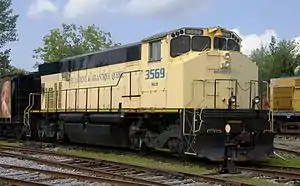MLW M-420
The MLW M-420 was a diesel-electric locomotive manufactured between 1973 and 1977 in Montreal, Canada by the Montreal Locomotive Works. A total 88 units were built for Canadian railways, including eight B units built for the British Columbia Railway; most of production went to Canadian National.[2] Only seven units were sold outside of Canada, to the State Railways Institution in Venezuela and Providence & Worcester in the United States.
| MLW M-420 | |||||||||||||||||||||||
|---|---|---|---|---|---|---|---|---|---|---|---|---|---|---|---|---|---|---|---|---|---|---|---|
 M420W #3569 of St Lawrence & Atlantic Railroad | |||||||||||||||||||||||
| |||||||||||||||||||||||
| |||||||||||||||||||||||
| |||||||||||||||||||||||
| |||||||||||||||||||||||
The M-420 was one of the first locomotive models (along with the EMD GP38-2) to use the wide-nosed Canadian comfort cab, pioneered by Canadian National. By the early 1990s, variations on this cab design had become the standard of the industry. As with wide-nosed General Motors Diesel units from the same period, references to the model commonly add a "W" at the end of the model name, but it is not part of the official model designation. Most M-420 units rode on MLW ZWT (Zero Weight-Transfer) trucks.
Variations
Other variations of the M-420 were the M-420R, the M-424 built for service in Mexico and the M-420TR switcher. The M-420R was built for Providence & Worcester using trade-in parts and rode on Type B trucks, but otherwise resembled the M-420. The M-424 was an M-420 with dynamic brakes uprated to 2,400 horsepower (1.79 MW). The M-420TR was built in two variations, with two M-420TR units sold to Roberval & Saguenay and fifteen slightly different units (sometimes referred to as M-420TR-2) sold to Ferrocarril del Pacífico. Both M-420TR variations bore little resemblance to the other models, with a lowered hood, shorter frame and end-cab design.
Service with CN and BCOL
The first Canadian National M-420 was delivered in 1973.[3] They provided service on the eastern side of Canada until their retirement in the late 1990s. By the time they were retired, many units were over 20 years old, and major Canadian railroads were purging their rosters of MLW and Alco locomotives to replace them with newer EMD and GE units. Bombardier HR-412s, purchased by CN and designed as successor to the M-420, were retired at the same time.[4]
Service as power generators in Winter 1998
During the winter of 1998, a severe ice storm cut off power to many homes and businesses in Ontario and Quebec. CN M-420 3502 was hoisted off the rails by crane and rolled along a street in Boucherville in order to provide power in the community. The engine was driven approximately 1,000 feet (305 m) under its own power to the city hall, where it then became a portable power generator.[5] M-420 3508 was also lifted from the tracks to provide power to a school being used as a shelter, but problems prevented this from happening, and 3508 remained on standby. Both engines suffered minor gear case damage and carved grooves in the pavement.
M-420 today
Following their retirement from CN and BC Rail, some M-420 units were scrapped, but many were sold to shortline railways across North America for continued service. Omnitrax purchased several units, including some of the M-420B units from BC Rail. Larger shortlines such as Omnitrax have begun to scrap or sell their MLW units as a result of increased maintenance and reliability issues. The St Lawrence & Atlantic Railroad used a fleet of eleven former CN M-420 units as road power from 1998 to 2001. The Great Western Railway in Saskatchewan used an entire roster of MLW M-420s until 2017 when they announced that they are replacing the MLW fleet with GE fleet.[6] Due to the high cost of painting, many M-420s on shortlines still retain their CN livery with the CN logo painted over. West Tennessee Railroad acquired three M-420s (3510, 3560, and 3576); 3510 was wrecked and scrapped, while the other two units remain in service in an maroon-and-gray paint scheme. Additionally, two M420 units operate under the ownership of Genesee Valley Transportation (GVT), one of which starred as No. 642 in the 1999 TV drama Atomic Train. Interestingly, this is the same number that the locomotive had while it was working for BC Rail. This locomotive currently wears its original BC Rail red, white, & blue paint scheme but the logos and company heralds have been painted over and replaced with the name and reporting marks of the Mohawk Adirondack & Northern (a subsidiary of GVT) It is numbered 2042.. The other GVT-owned M420 operates out of Scranton, PA on the Delaware-Lackawanna Railroad (also a GVT subsidiary) as No. 2045 (former BCOL 645) and wears GVT's corporate scheme.
Original owners
| Railroad | Quantity | Road numbers | Notes |
|---|---|---|---|
| Canadian National[8] | 80 | 2500–2579 | |
| British Columbia Railway[9] | 16 | 640-647 & 681-688 | 681-688 are cabless B units |
| Argentine State Railway | 2 | M001, M002 | |
| Providence & Worcester | 5 | 2001–2005 | M-420R |
| Roberval & Saguenay | 2 | 26, 27 | M-420TR |
| Ferrocarril del Pacífico | 15 | 522-536 | M-420TR |
See also
References
- "M420W Data Sheet". Retrieved 2009-02-27.
- "M420W Production". Retrieved 2009-02-27.
- CN gets its first M420 diesel Railway Age 11 June 1973 page 37
- "CN Locomotives - Retired". Archived from the original on 2009-09-13. Retrieved 2009-07-07.
- "M-420W derailed". Archived from the original on 2009-02-25. Retrieved 2009-03-04.
- "Great Western Railway". Retrieved 2009-02-27.
- "Roster". Retrieved 2009-03-04.
- "CN Roster". Archived from the original on 2009-02-25. Retrieved 2009-03-08.
- "BCOL Roster". Retrieved 2009-03-04.
External links
![]() Media related to MLW M-420 locomotives at Wikimedia Commons
Media related to MLW M-420 locomotives at Wikimedia Commons